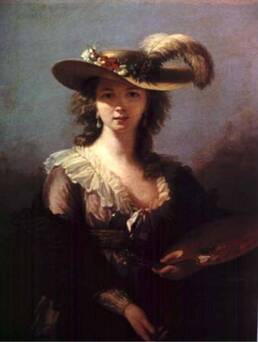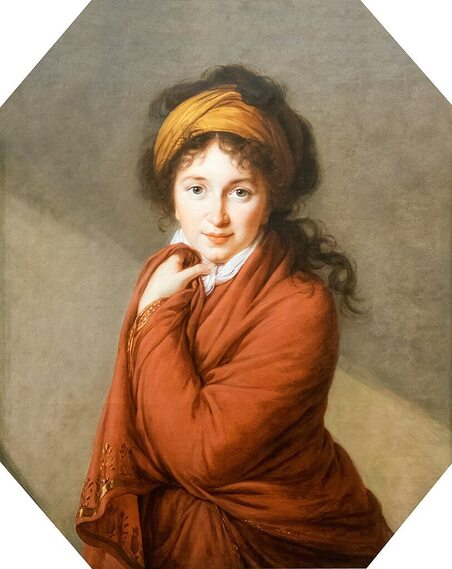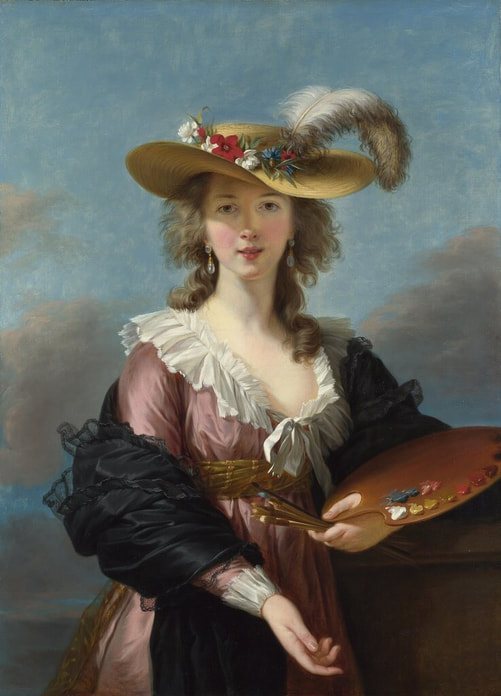|
Where? The Barber Institute of Fine Arts in Birmingham, England.
When? About 1800 Commissioned by? Most likely painted for the Golovine family. The painting remained in their possession until approximately 1978, when it was acquired by Gooden and Fox, then it was sold to the Barber Institute of Fine Arts in 1980. What? Oil on canvas, octagonal, 32 7/8 by 26 1/4 inches (83.5 by 66.7 cm.) What do you see? No matter what room this portrait of Countess Barbara Nicolaievna Golovine is in, it will be the first painting to demand attention. The innovative composition is a half-length figure in an octagonal shape and is further enhanced by an attractive gold frame. Vigée Le Brun has wrapped her subject entirely in a large, thick, rich, red stole with gold embroidered trim. The luxurious wrap is draped carefully but casually, and held gracefully at her neck by one hand, as if she has just come from her boudoir or the bath. The red shawl commands immediate attention. Her loose and free, brown, curling hair tumbles around her face and shoulder, held in place by a deep golden headband that has a twist and texture that adds to the framing of her face. There is a dimple in her chin that augments the slight smile on her face and blends gracefully with the shadows of the light and dark. In fact, the dimple makes her face much more interesting. The neutral, scumbled background has a diagonal shaft of light cutting across the canvas that adds clarity to her hand and facial features. It is an unusual backdrop that suits the countess’s dynamic pose. She faces us, while her body turns slightly to the left, suggesting motion. There is an erotic hint to the painting but that is over-whelmed by the soft smile and the warmth of her eyes as she engages the viewer. She is pleased to see her visitor, a friend, a well-liked friend, who will be welcomed and entertained with excellent conversation, perhaps a glass of French wine, for she was a member of the Russian Aristocracy, a Princess first, then a Countess, when friendships, manners and virtue mattered more than anything. As the viewer turns away, moving either to the left or right, a glance over a shoulder confirms that her eyes are following as she bids her farewell……it is not a portrait easily forgotten by anyone who views it, and one that many, return to view again and again.
0 Comments
 Original version of Self Portrait in a Straw Hat (1782) Original version of Self Portrait in a Straw Hat (1782)
Where? Room 33 of the National Gallery in London
When? 1782 Medium and size: Oil on canvas, 97.8 × 70.5 cm. What do you see? A self-portrait of the 27-year old Élisabeth Vigée Le Brun. She painted herself standing outside, wearing a straw hat with an ostrich feather and a garland of wildflowers. And she holds a palette and seven brushes in her left hand. She portrayed herself as an independent and emancipated woman, traits that helped her to become a successful artist in a male-dominated art world. Many other young ladies would have worn a corset, a wig, and a lot of make-up. Instead, Vigée Le Brun portrays herself in a fashionable, pink cotton dress, a black shawl, a straw hat, a pair of earrings, and her own hair. Vigée Le Brun paid particularly careful attention to the impact of two light sources, the sunlight and the daylight. The impact of the sunlight is apparent when looking at how she painted her eyes in the shadow of the straw hat. The result is that the viewer is naturally directed to look at her neck and chest. Backstory: The painting in the National Gallery is actually a copy of a version she made earlier in 1782 and exhibited at the Paris Salon. The original painting is in a Swiss private collection and only a low-resolution image of it is available. The self-portrait of Élisabeth Vigée Le Brun was inspired by the Portrait of Susanna Lunden (c. 1622-1625) by Peter Paul Rubens, which is also part of the collection of the National Gallery. In 1782, during her travels with her husband, she came across Rubens’ portrait in Antwerp. She was particularly impressed by the way Rubens simultaneously incorporated the effects of both natural daylight and sunlight. She immediately started to apply these ideas to her own portrait. After she returned to Paris, she created a second version of this painting, which is the one in the National Gallery today. The same year she also painted the Portrait of Yolande-Martine-Gabrielle de Polastron, Duchess of Polignac, which has a quite similar composition. |
Categories
All
|
- Home
- Blog
-
Museums
- Alte Pinakothek
- Art Institute of Chicago
- Baltimore Museum of Art
- Barber Institute of Fine Arts
- Bargello
- Barnes Foundation
- British Museum
- Church of Sant’Anastasia
- Cleveland Museum of Art
- Courtauld Institute of Art
- Detroit Institute of Arts
- Frans Hals Museum
- Galleria Borghese
- Gallerie dell'Accademia
- Getty Museum
- Guggenheim
- Hermitage Museum
- Kunsthistorisches Museum
- Kunstmuseum Basel
- Legion of Honor Museum
- Louvre
- Mauritshuis
- Metropolitan Museum of Art
- Musee d’Orsay
- Museum of Fine Arts in Boston
- Museum of Modern Art
- National Gallery in London
- National Gallery of Art
- National Museum in Poznań
- Norton Simon Museum
- Ny Carlsberg Glyptotek
- Palace of Versailles
- Palazzo Pitti
- Palazzo Vecchio
- Petit Palais
- Philadelphia Museum of Art
- Prado
- Pushkin Museum
- Ravenna Art Museum
- Rijksmuseum
- San Diego Museum of Art
- Santa Maria delle Grazie
- St. Peter's Basilica
- Städel Museum
- Statens Museum for Kunst
- Tate Britain
- Tate Modern
- Timken Museum of Art
- Uffizi
- Vatican Museums
- Wallace Collection
-
Artists
- Altdorfer
- Anguissola
- Berlin Painter
- Bosch
- Botticelli
- Boucher
- Bronzino
- Bruegel the Elder
- Brunelleschi
- Cabanel
- Caillebotte
- Canova
- Caravaggio
- Carpeaux
- Cezanne
- Cimabue
- David
- Degas
- Delacroix
- De Maria
- Donatello
- El Greco
- Fontana
- Fra Angelico
- Fragonard
- Gauguin
- Gentileschi
- Gericault
- Gonzalez-Torres
- Goya
- Hals
- Hogarth
- Hokusai
- Ingres
- Leonardo da Vinci
- Lippi, Filippo
- Longhi, Barbara
- Lorrain
- Makovsky
- Manet
- Massys
- Matisse
- Merian
- Michelangelo
- Mochi
- Modigliani
- Monet
- Panini
- Parmigianino
- Perugino
- Picasso
- Pisanello
- Raphael
- Rembrandt
- Renoir
- Reynolds
- Rivera
- Rodin
- Rubens
- Scultori
- Seurat
- Steen
- Tintoretto
- Titian
- Toulouse-Lautrec
- Turner
- Uccello
- Van der Weyden
- Van Dyck
- Van Eyck
- Van Gogh
- Van Hemessen
- Vasari
- Velazquez
- Vermeer
- Veronese
- Vigée Le Brun
-
Locations
- Books
- About Us


